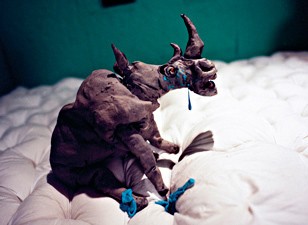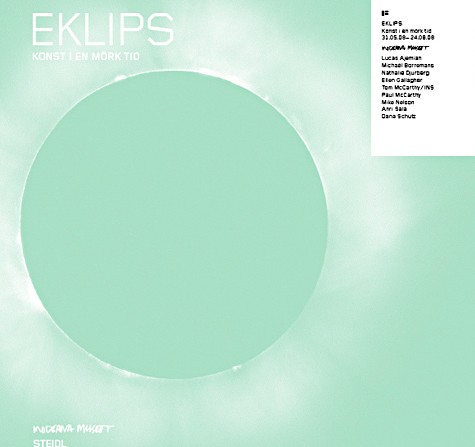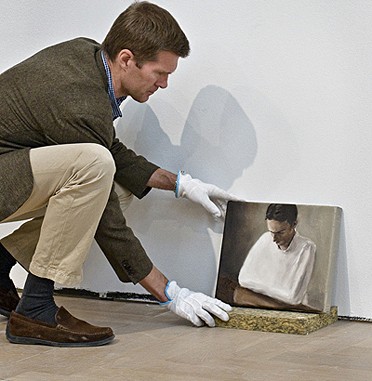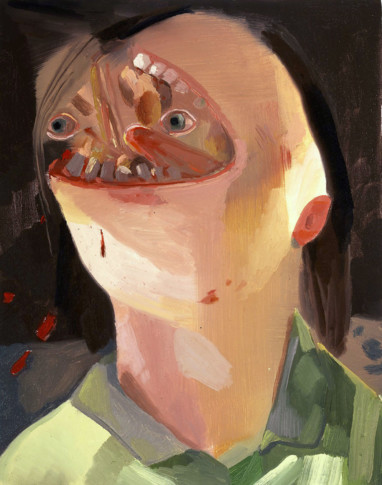
Nathalie Djurberg, The Rhinoceros and the Whale, 2008 © Nathalie Djurberg
Twilight Vision
In the west, this has resulted in higher security alerts and tougher surveillance of ordinary citizens. Human rights have been violated in the name of security: The US prison camp on Cuba is merely one example. Apart from geo-political crises, we read daily reports on hurricanes, floods and melting glaciers. Many people are speculating on what will happen when large populations in China and India adopt the consumerist lifestyle characteristic of the west. The short period of optimism that followed the fall of the Berlin Wall and the abolishment of the apartheid system feels very distant today.
Nevertheless, there are some glimmers of light. Starvation and illiteracy are diminishing in the world. In the west we have been surfing for a long time on an exceptional economic boom, although it appears to have passed its climax now, and many scientific achievements today would have appeared like science fiction only a decade ago. Just think of the progress in biomedicine and IT. The information and knowledge society can be seen as a sign that we are living in the most enlightened age ever. And yet, there is a growing ambivalence with regard to the enlightenment and the modern project. On the one hand, we see how it has served as an alibi for colonialism and imperialism (the spreading of one’s culture to the “savages” using weapons); on the other, the philosophy of the enlightenment includes many ideas and ideals (critical thinking, freedom of speech) that many, not least artists and intellectuals, believe are worth fighting for. Today, we see increasing intolerance, a “clash of civilisations” (the political scientist Samuel P. Huntington ominously identifies cultural differences as a source of conflict). Intolerance is found in both left and right wing politics. In the USA, the Christian conservatives have spoken up against artistic expression that they consider offensive. And in the name of political correctness the liberals and left-wing intellectuals risk developing norms for what is permissible to say and a form of consensus on how modern man should think. There are a worrying number of taboos and to avoid annoying one group or another requires great caution. Those artists who defend the right to say the “wrong” things are obviously moving in the opposite direction. In an essay in the catalogue for the Whitney Biennial in 2006, Toni Burlap concludes with a reflection on the art project The Wrong Gallery, and quotes the Biennial curators: “The opposite of ‘right’ is not ‘left’, but ‘wrong’. Since the world seems to be moving inextricably toward the right – an impulse repressed since the ground zero of the end of World War II – to be wrong is to be the opposition.” To be “wrong” in relation to one’s own era – to break against consensus – can involve formulating a new position that will prove to be crucial to the future. To be wrong and to refuse to conform to the cut-and-dried positions of the prevailing discussion, can be a conscious strategy and a form of resistance. It is also an approach that creates greater potential for more interesting and less predictable art. This approach is what unites the artists in the Eclipse exhibition. They also share the ability to use the freedom to speculate which fiction affords, and a fascination for the dark side.
Darkness and blackness do not exclude humour – on the contrary, an anarchic humour permeates many of the works in Eclipse. This is particularly true of Nathalie Djurberg and Paul McCarthy. The latter’s works balance between buffoonery and a fury that seems to emanate from the very darkest core of mankind and therefore terrifies. “Balance” is, of course, the wrong word to use for McCarthy’s art, since it is characteristically unbalanced. The simultaneously threatening and pathetic father figures McCarthy plays in his performance-based video works and installations are a hazard to themselves and their surroundings since they lose control, both of the situation and their bodies. The violence that lurks under the surface and erupts capriciously is always inexplicable and absurd.
McCarthy often uses masks from toyshops and costume shops. Mythological Disney and Hollywood characters are mixed with real politicians, albeit warped and exaggerated. “That’s the way I see them,” he explained at a question session at Moderna Museet. “They are not real, they are virtual.” The boundary between drama, fiction and reality is fuzzy. This is a tendency found in many parts of the world but is nowhere as blatant as in McCarthy’s hometown Los Angeles, California, where both Ronald Reagan and Arnold Schwarzenegger have proceeded from Hollywood’s dream factory to the highest sphere of political leadership.
The figures in Nathalie Djurberg’s animated films are driven by obscure desires. The imagery and the materials are culled from the innocent fairytale world of children’s TV. But innocence soon turns into cruelty. Her films are full of assault and violence – often against the supposedly weak and vulnerable, for instance young girls, but just as often with sadistic vengefulness against the perpetrators, against power. If we laugh, it is not without a tinge of guilt – is this really permissible? The fact that the violence takes place in a pretend world does not make the issue less troubling – in a sense it just makes it clearer. The complexity lies in the fact, for instance that we can set up alternative rules for fictive worlds and that virtually anything is possible there. And that art, at one and the same time, can both be a metaphor for reality and create its own reality.
The myths and legends generated by Mike Nelson include the one that some of his works were made in collaboration with a biker gang of Kuwait veterans who call themselves The Amnesiacs. They see visions in the form of flashbacks they cannot interpret, but which Mike Nelson helps them to reconstruct and turn into pictures or sculptures. This reconstruction of memories also appears in Tom McCarthy’s first novel, Remainder. Mike Nelson’s installations have been described as “fake ready-mades”. He builds environments that seem to be “found” and perhaps slightly modified to enhance an atmosphere or cause a shift in meaning. In fact, they are more or less entirely fabricated, created from scratch in the same way that a painter would start with an empty canvas. the places he builds seem to bear the imprint of a history, a hidden story tied to people on the margins of society. The myths and stories, despite being purely fictive, can be read metaphorically and can concern political and social issues. In Mike Nelson’s apparently abandoned hiding-places we sometimes find books by for instance Stanislav Lem, the Polish author who used the science fiction genre as a means of writing about the real situation without being stopped by censors.
To use fictive “agents” in creating art adds a further interpretative level to the works and gives them a speculative, occasionally ironic, undertone. It also generates greater freedom to try ideas that one may otherwise have found impermissible. Mike Nelson shares this method with several artists in his generation. Where the artist Mike Nelson created a fictive group, The Amnesiacs, there are many other cases where groups have created a fictive artist. Reena Spauling, Claire Fontaine, Otabenga Jones and other artists are products of various artist collectives. This raises questions about originator and authenticity. It is a play with alternative identities, a way of gaining scope for freer thought. It serves as a mask. The International Necronautical Society (INS) is an artist group that is a pastiche on early 20th century avant-garde movements such as the surrealists who organised themselves and wrote manifestos. Despite their artistic and conceptual radicalism, these avant-garde groups may appear rather bureaucratic today in their organisation. The activities of the INS include hearings with various representatives of the art sector. Tom McCarthy is the secretary general of the INS and has written reports for the Society. The second report is reproduced in this catalogue. The context of the report he presents, an art project where he played an important part as the secretary-general, a sort of persona, creates a detachment to the contents of the report. In itself, the report can be seen as a highly speculative and theoretical platform for the aesthetics and practices of the Society. The key concept is that art harbours subversive, encoded messages with a politically explosive potential. Codes usually have only one key that enables the holder to read the exact message. In this sense, codes differ in a more literal sense from artistic expressions that have numerous possible interpretations. What unites them is the idea that everything has multiple layers of meaning and the veritably paranoid desire to read between the lines. Lucas Ajemian’s performance Out of Nowhere/From Beyond again alludes to art as the vehicle of encoded messages. Together with an orchestra conducted by his brother Jason Ajemian who is a musician, he performs a version of the heavy-metal band Black Sabbath’s track Into the Void backwards. There is a distinct reference here to the countless myths claiming that hidden, often satanistic, messages are revealed when the music is played backwards. The result is surprisingly evocative and powerful.
Speculation and shady, ambiguous messages are also characteristic of the world that Michaël Borremans conjures up. At first glance, his paintings and drawings appear realistic, but in view of the subject matter it would be more correct to call them surrealistic. Michaël Borremans has said that he makes drawings and creates situations that do not need to work in reality. The drawings can sometimes look like sketches for absurd public art or monuments. In that respect, they can be interpreted as metaphors for the potential of art to create new worlds, to construct models of possible realities. But they often have an unsettlingly chilly undertone of violence, domination and manipulation that suggests the models used by war commanders, for instance in his large painting Trickland (I-Large). The remarkable scenes he paints are easy to interpret in an existential way, as absurd metaphors for the human condition.
The obscure and enigmatic quality of Borremans’ paintings has a correspondence in some of Anri Sala’s video works, several of which are shot in semi-darkness. They are often reduced to a seemingly straight-forward scene. This can be a man who is about to fall asleep in a church, or a horse standing dangerously close to a road with heavy traffic. Due to the absence of explanatory information the images soon deliver more questions than answers. The films often have distinctly formal or structural aspects that require us to sharpen our senses. We can also try to understand the films metaphorically. In Ghostgames and time after time, for instance, it is possible to interpret the uncomprehending animals that are startled by the electric light as images of alienation – but other interpretations are equally possible, and the viewer must try to construct meaning out of the highly-charged images.
Ellen Gallagher moves in a mysterious world – but with a historic background: Coral Cities is a series of works based on a legend about the slaves who died on the inhuman passage from Africa to America. The dead or dying were thrown overboard. According to the legend, some of the unborn infants survived in their pregnant mothers’ wombs. They were born with gills and founded an underwater oceanic community – another world. Dana Schutz also creates mythical worlds. At first glance, her paintings appear expressionistic, but they often spring from an idea, a supposition about what things would be like under certain conditions. In her first exhibition she portrayed a post-apocalyptic world and the only surviving man, Frank. In other paintings the women appear to be the strongest and in charge. She paints an ambiguous doomsday picture – if we are not living in the best of worlds, then perhaps other possible worlds are not that much worse?
Eclipse means an obliteration of the sun, and this exhibition is an encounter with art that looks into darkness; both that which follows on the crisis of the Enlightenment, and the darker side of mankind – irrational urges and desires that are rarely brought out into the open. It is also about embracing life in all its complexity – to make the repressed and invisible visible. The darkness represents the unknown and that which lies beyond the accepted concepts and therefore defies explanation. To set off into the darkness is necessary in order to discover something new. But it also involves challenging established truths and conventions – an avant-garde stance that has been so central in the history of modern art that it has come to be a convention in itself (which in turn can be challenged). Ever since the breakthrough of modernism, the unfitting and incorrect has been a cure against boredom and dogma: there are countless examples of this, from Duchamp, dada and surrealism, to pop and performance artists. Challenging and scepticism are the very foundations of a searching and explorative approach, and in an era when critical thinking is under threat art that refuses to conform can be a safeguard for the freedom of thought, speech and image. A questioning of authority in defence of independent thought is, after all, a cornerstone of the Enlightenment.
This explorative approach has, to some extent, meant that art has had to find new roads also with regard to meeting the public. A critical stance to art institutions arose in the 1960s and 1970s and opened a door to other ways of working and communicating with the audience, for instance in urban spaces or via the media. This generated a greater awareness among both institutions and the public to the fact that not even the white cube is a neutral space but a place charged with meanings and values. In the 1990s, this institutional critique was coupled with a desire among many artists and curators to act in the social and political reality beyond the gallery or museum walls. This desire to make art political and incorporate it in society has an opposite pole in the conservative camp which insists that art is autonomous, unconnected with the rest of society. Both standpoints, however, presuppose that art and social and political reality are separate, for better or for worse. The philosopher Jacques Rancière claims, instead, that “art is not political by virtue of the messages and feelings it conveys about the order of the world. Nor is it political in the way it portrays social structures, the conflicts or ideas of social groups. It is political in the very distance it puts between itself and these functions…” Art, according to this view, does not need to be about political issues in order to be political. More important is that it opens up for new ways of seeing and thinking. Art achieves this rather by its distance to the prevailing political discussions, by finding other languages, other values. Utopias and other extremes only become a real threat if we try to make them come true. In art they are potential tools for thought. In art virtually anything is possible. That’s the whole point.



